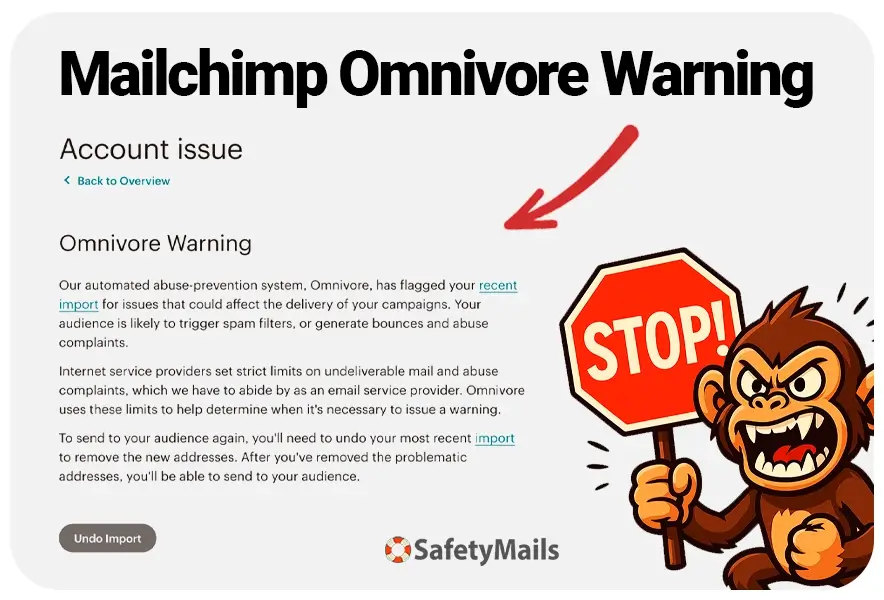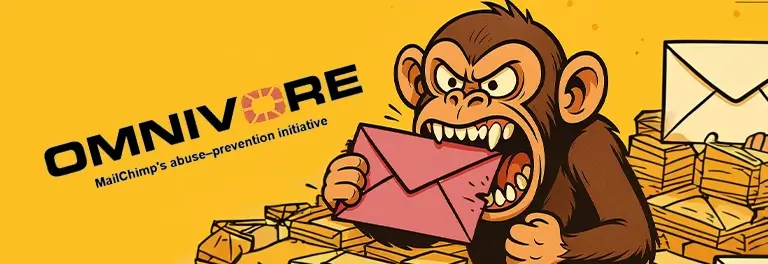Mailchimp’s Omnivore warning is activated every time you import new contacts or try to send a campaign to a list that has not yet received emails from your account. Therefore, verifying the emails in your lists is essential to solving this problem. Verifying lists before uploading avoids the warning.
Email marketing is one of the most effective strategies for reaching customers and prospects, but it requires care and attention to work well. If you’re a Mailchimp user reading this post, you’ve probably come across the Omnivore Warning – a notification that interrupts your campaign sending plans and can be a headache.
But what does this warning mean? Why does it appear? And, more importantly, how do you resolve it?
In this article, we’re going to take a deep dive into the world of Omnivore, Mailchimp’s automated system that promises to protect the deliverability of your emails. We’ll explain what it is, why it issues warnings, how you can fix the problem and what the best practices are to prevent it from happening again.
Table of Contents
What is Mailchimp Omnivore?
Omnivore is an automated system developed by Mailchimp to prevent abuse by analyzing email lists before you send a campaign, identifying possible problems that could compromise deliverability (the ability of your emails to reach the recipients’ inbox).

In other words, Omnivore seeks to protect the reputation of both Mailchimp and its users against bad practices in the collection and management of email addresses.
When uploading a new mailing list, Omnivore checks the email addresses for signs of risk, such as:
- Invalid emails: addresses that do not exist or are badly formatted (example: “usuario@dominioerrado”).
- Spamtraps: email addresses created by internet providers or anti-spam organizations to identify senders of unwanted messages.
- Addresses prone to complaints: e-mail addresses of recipients who have a history of marking messages as spam (complaints).
If Omnivore finds a high number of problem emails, Mailchimp will issue a warning and block the campaign from being sent until the problem is resolved.
According to Mailchimp, this process is essential to prevent you from sending emails that could damage your reputation as a sender or that of Mailchimp itself with email providers. Hard bounces and spamtraps are especially damaging to sender reputation, leading to blocking and blacklisting.
What practices can lead to an Omnivore warning?
There are several practices that can cause your mailing lists to trigger Omnivore’s warning. Here are the main triggers:
1. invalid or badly formatted e-mail addresses
Emails with typos (such as “[email protected]” instead of “[email protected]”) or non-existent domains are quickly identified by Omnivore.
2. Outdated e-mail lists
If you haven’t sent emails for months or years, many addresses may be obsolete. People change email accounts, abandon old addresses or switch providers, making these contacts invalid.
3. Lists with role-based addresses
Mailchimp has specific limits for role-based addresses, such as “[email protected]” or “[email protected]”. These emails, shared by several people, are more likely to generate spam complaints, which can trigger Omnivore.
Mailchimp claims that it excludes all these e-mail addresses during the upload process.
These are some of the addresses that can be blocked during upload:
- abuse@
- admin@
- billing@
- compliance@
- devnull@
- dns@
- ftp@
- hostmaster@
- inoc@
- ispfeedback@
- ispsupport@
- list-request@
- list@
- maildaemon@
- noc@
- no-reply@
- noreply@
- null@
- phish@
- phishing@
- postmaster@
- privacy@
- registrar@
- root@
- security@
- spam@
- support@
- sysadmin@
- tech@
- undisclosed-recipients@
- unsubscribe@
- usenet@
- uucp@
- webmaster@
- www@
4. Spamtraps
Spamtraps are traps (aka honeypots) designed to catch senders who use inappropriate practices, such as buying mailing lists. If your list contains such addresses and Mailchimp knows what they are, Omnivore will take action.
How to fix the Omnivore warning
Receiving a warning from Omnivore can be a scare and a headache. But it’s actually an opportunity to improve your email marketing strategy.
To resolve the warning, follow this step-by-step guide:
Step 1: Identify the warning
When Omnivore blocks a campaign, you’ll see a message in Mailchimp indicating the problem.
Unfortunately, Omnivore doesn’t indicate which addresses are problematic. You will therefore need to analyze and clean your entire list.
Step 2: use an e-mail verification service
Tools such as SafetyMails are ideal for identifying and removing:
- Invalid emails
- Spamtraps
- Disposable / temporary emails
- Role-based addresses
- among others
Email verification is a specialized process that helps protect companies’ online reputation and brings numerous benefits, such as reducing the cost per lead, improving deliverability and reducing operating costs.
Step 3: Update your list on Mailchimp
After verifying the mailing list, remove the problematic addresses identified. Then update your mailing list in Mailchimp. You can do this manually or import a new clean list to replace the old one.
Step 4: try sending again
With the list cleaned and updated, try resending your campaign. If everything is correct, Omnivore will allow you to send it. If not, the block will remain active.
Best practices to avoid Omnivore warnings in the future
Resolving an Omnivore warning is important (and emergency), but prevention is even better.
Here are some tips to keep your list healthy:
1. Use double opt-in
With double opt-in, subscribers confirm their interest by clicking on a link after signing up. This reduces the chance of adding invalid or non-consenting emails.
2. Implement email verification
Make email verification a business practice to maintain quality in email marketing.
Consider carrying out periodic checks in order to avoid the risks associated with outdated mailing lists.Here’s a list of mistakes you should avoid in order not to fail with your email verification.
3. Get away from bought lists
Build your mailing list organically with forms on the site, events or promotions. Plus, add an extra layer of protection against invalid and risky emails with SafetyMails’ real-time email verification API.
Purchased lists are a shortcut to trouble. Firstly, because these lists contain numerous invalid emails, as well as spamtraps. Secondly, because purchased lists are not authorized to be sent, they flout data protection laws and are also subject to spam complaints.
4. Keep sending consistently
Sending emails regularly keeps your subscribers engaged and prevents contacts from becoming stale. If a mailing list goes for a long time (more than three months) without sending, we recommend rechecking the emails to avoid problems with hard bounces.
Consequences of ignoring Omnivore
To put it bluntly, ignoring Omnivore’s warnings can lead to serious problems:
- Account suspension: according to Mailchimp, three warnings in six months can lead to permanent account suspension.
- Damaged reputation: Sending emails to bad lists affects your deliverability, sending more messages to the spam folder. It can then lead to blocking and, finally, blacklisting.
Treat each warning as an opportunity to act quickly and avoid the sanctions provided by Mailchimp. Proactivity is key!
Mailchimp Omnivore Pros and Cons
Although Mailchimp developed Omnivore to protect the reputation and quality of email marketing campaigns, the main objective is to protect Mailchimp itself and its infrastructure.
As such, it’s possible to say that not everything in Omnivore will work positively for your work. That’s why it’s important to consider the pros and cons of Omnivore.
Omnivore’s pros
- Prevents you from sending potentially harmful emails
- It seeks to protect the reputation of your email marketing and also Mailchimp’s sending infrastructure.
- It’s a temporary interruption, but not an account suspension.
Cons of Omnivore:
- The system is not specialized in email verification and has a significant margin of error.
- It can interrupt an important email marketing campaign and will require time to resolve.
- Three warnings in a 6-month period leads to account suspension, which can be permanent.

Conclusion
The Omnivore warning in Mailchimp is not a monster, but it should be taken as an important sign that you need to adjust your email list collection and management practices.
The purpose of Omnivore is to protect your reputation and help ensure that your outgoing emails reach the right destination and, above all, the inbox. By understanding what Omnivore does, cleaning your lists properly and adopting good practices, you can turn this challenge into an opportunity to improve your email marketing.
FAQ
What is Mailchimp’s Omnivore and why does it issue warnings?
Omnivore is an automated Mailchimp system designed to protect the deliverability of email campaigns. It kicks in whenever a user imports a new contact list or tries to send a campaign to a group that hasn’t yet received messages from that account. Omnivore’s aim is to identify and block lists containing invalid emails, spamtraps or addresses with a history of spam complaints, thus preventing the reputation of both the sender and Mailchimp itself from being compromised. When it detects risks, the system issues a warning and blocks the campaign from being sent until the problems are resolved.
What types of emails can cause Omnivore warning?
Several types of email addresses are considered problematic by Omnivore and can lead to the sending being blocked. Poorly formatted addresses or addresses with non-existent domains are quickly flagged as invalid. Out-of-date lists, which have not been sent to for months or years, also often contain obsolete emails. In addition, Mailchimp limits role-based emails, such as “admin@” or “sales@”, as they are more prone to complaints. Finally, the presence of spamtraps (trap addresses created to catch inappropriate practices) is also a trigger for warning.
What should I do when I receive a warning from Omnivore?
When you receive a warning from Omnivore, the first step is to identify the notification within the Mailchimp platform. The system doesn’t pinpoint the exact addresses that caused the problem, so you need to check your entire mailing list. The best way to do this is to use an email verification service, such as SafetyMails, which identifies and removes invalid emails, temporary emails, spamtraps and role-based addresses. After cleaning, simply update the list in Mailchimp, replacing the problematic contacts with a verified version. Once the list is clean, you can try sending again.
How can I avoid new Omnivore warnings in the future?
The best way to avoid future warnings is to adopt good email list management practices. Implementing double opt-in ensures that only interested and valid contacts enter the database. In addition, it is essential to carry out periodic list checks and not to use purchased lists, which do not have permission to send and generally contain poor quality emails and spamtraps. Maintaining a consistent mailing routine also helps prevent emails from becoming obsolete. The more up-to-date and engaged your list is, the less chance you have of being blocked.
What are the consequences of ignoring Omnivore’s warnings?
Ignoring warnings issued by Omnivore can have serious consequences. Mailchimp makes it clear that three warnings within a six-month period can result in the account being permanently suspended. In addition, sending emails to bad lists damages deliverability, causing your messages to land in the spam folder and even leading to the sender being blocked by ISPs. Therefore, every warning should be treated as an opportunity to correct and improve the email marketing strategy, ensuring the continuity of campaigns and the good reputation of the brand.



